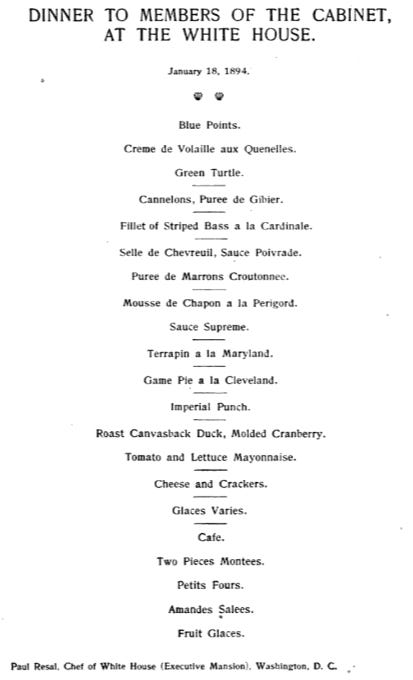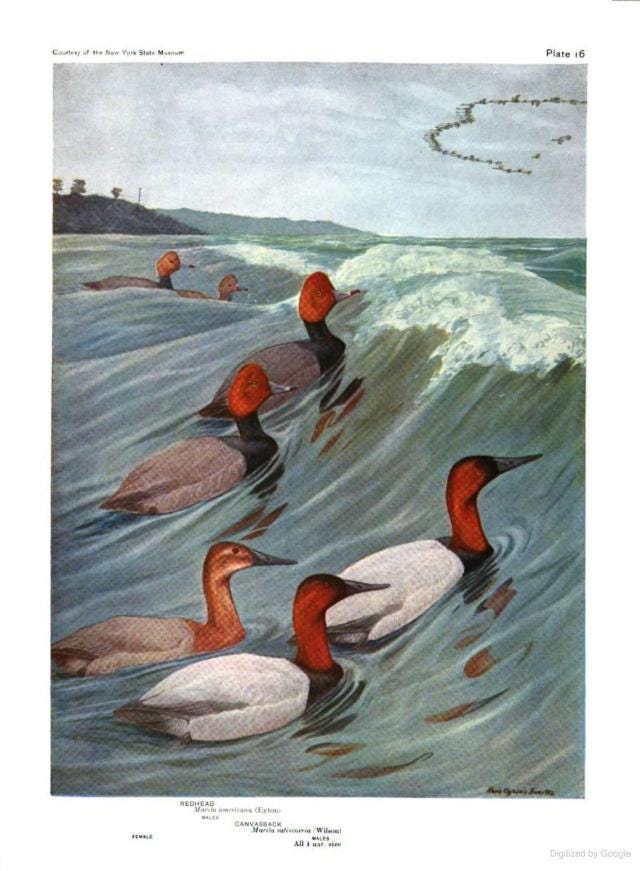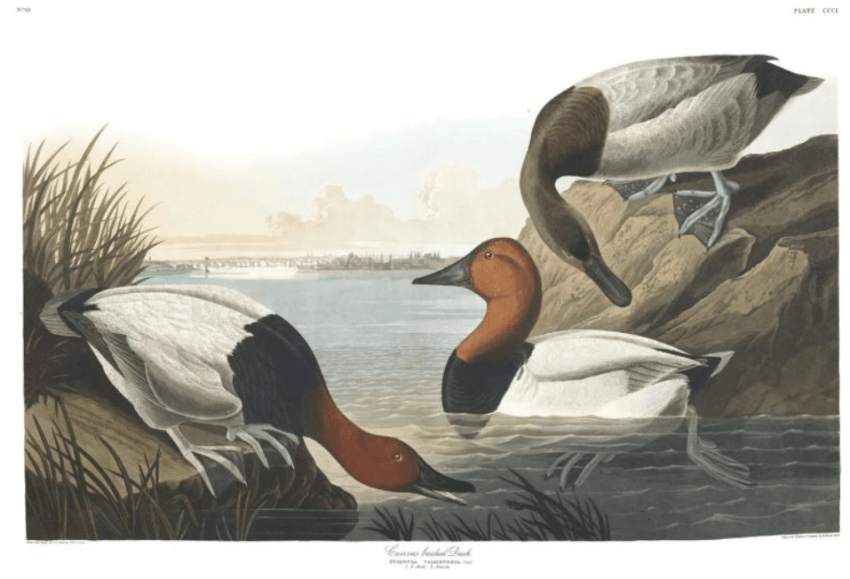Eating King Can
If you've never heard of a canvasback, you're not alone. But a hundred years ago, this duck was America’s most famous — and most exclusive — dish.
“So well and so widely known that its very name has passed into an epicurean proverb, the canvasback needs no introduction.”1 These words were doubtlessly true when they were written in 1901. But today, unless you are an avid hunter, birder, or historian of 19th-century American dining, I would guess that you do, in fact, need an introduction to the once-famous canvasback.
Canvasbacks are North America’s largest and fastest species of duck. Today, they’re also one of its rarest. These birds got their name from the white feathers on a male’s sides and back, “which very much resemble coarse canvas.”2 The head and neck of male birds is a rich chestnut, and birds of both sexes can be recognized by their long, sloping bills that some call aristocratic. This species of duck can be found from Canada down to Mexico, but they are most famous for gathering on Chesapeake Bay, which holds an abundant supply of their favorite food. Canvasbacks have a particular fondness for a species of aquatic plant called wild celery, or Vallisneria americana, from which the duck gets its scientific name, Aythya valisineria.

It’s also because of this fondness for wild celery that canvasbacks were pursued relentlessly by 19th-century hunters. “It is this diet that imparts to the flesh of the canvasback the requisite delicacy of flavor,” said Harry Oberholser in 1901, “and when, after having lived upon this for some weeks, the bird becomes, in the late fall, most fit for the table.”3 Roast canvasback used to be America’s most famous — and most expensive — dish, until the birds nearly disappeared because of overhunting. After decades of protection and rehabilitation, today’s canvasback population is now stable. But it’s worth looking back at a time when “King Can” was the “best known of all American ducks, not excepting even the Mallard.”4
When Canvasback was King
When 19th-century English travelers visited the United States, they eagerly sought out the famous canvasback, which lives nowhere outside North America. In 1833 James Stuart wrote that on his visit to America, he “first saw here in perfection the canvas-back duck of the Potomac, which is reckoned, and I think justly, the greatest delicacy in the United States.”5 The exquisitely-named George William Featherstonhaugh agreed, when in 1844 he made his “first essay upon what is universally allowed to be the greatest of all delicacies in the United States, the Canvas-back duck.”6
Featherstonhaugh was at first disappointed to see the birds served without “a single drop of gravy,” as “everyone knows that a quantum sufficient of good gravy is to English rotis what fine sunny weather is to the incidents of life, enabling them to pass along smoothly and pleasantly.” However, when his host “took up the carving-knife, and [made] two incisions in the fat breasts of the birds, the dish instantly became filled with the desired fluid.” After eating his fill, the English traveler was satisfied to pronounce that “the tenderness, the juiciness, and the delicate flavour” of the canvasback “distinguish him above all other birds when brought to the table.”
Throughout the 19th century, America’s cuisine was synonymous with its game. The country’s food was best put on display not through an accomplished command of technique or masterful use of spices, but through its seemingly limitless number and diversity of edible animals. To honor the visit of British minister Lord Napier to the US Capitol in 1859, for example, Washington, DC’s Willard Hotel served 1,800 guests a grand banquet of “canvas-back ducks from the Delaware, reed birds from the Savannah, wild turkeys from Kentucky, prairie hens from Iowa, mutton from the Cumberland mountains, venison from North Carolina, and other ‘native American’ dishes.”7
Among this edible menagerie, canvasbacks stood supreme. Sportsmen and hunters called them the “king of ducks.”8 The famous Delmonico’s chef Alexander Filippini said that “as a highly prized delicacy, it stands without a rival.”9 And their price reflected this exclusive distinction. They were usually the most expensive item on restaurant menus. The birds were even shipped to Europe, where they could sell for 25 dollars a pair.

Throughout the gilded age, canvasbacks were a fixture of high-society dinners. In The Age of Innocence, Edith Wharton described how they were served to the New York aristocracy: “After a velvety oyster soup came shad and cucumbers, then a young broiled turkey with corn fritters, followed by a canvas-back with currant jelly and a celery mayonnaise.” The 1897 White House Cook Book suggested that before serving canvasbacks, “place them for a moment before the host, so that all the guests can see them. Cut off only the breasts, and serve with a little of the gravy and a small piece of fried hominy, on very hot plates; then pass around the currant jelly.” Many “epicureans” — what today we’d call foodies — held that “this special kind of bird requires no spices or flavors to make it perfect.”10

The Big Scam
Since the right canvasback commanded such a premium over any other duck, quite a few salesmen were willing to cut corners to turn a little extra profit. There is another kind of duck, called a redhead, that looks similar enough to canvasbacks. As far back as the 1810s, customers who were not ornithologically inclined were sold redheads in their place at markets, as unscrupulous vendors who could pass them off as canvasbacks might take home three times the price.

And once the duck was plucked and cooked, it was nearly impossible to tell a canvasback and a redhead apart. Wary diners knew this was a risk, so some restaurants tried making this scam more convincing by bringing out the dish with a real canvasback’s head placed before the body of a cheaper duck, meaning that “one canvasback head will often act as honorary pall bearer at the gastronomic rites of a hundred mallards.”11 It was an open secret that restaurants substituted one duck for another, with one writer claiming that “there is no shame about it, because it is one of those things that are taken for granted.”12
But the truth of the matter was that in the hands of capable chefs, canvasbacks did not taste all that different from other ducks. This even became the subject of a popular joke: “What’s the difference between a redhead and a canvasback?” “Easy,” went the response, “it’s in the bill!” As Lynn Meekins wrote in a 1913 story in the Saturday Evening Post, “any one familiar with ducks can tell the canvasback from the redhead by a look at the head and the bill; but when the ducks are served I doubt whether one man in a thousand could be sure of the difference.”13

Like so many luxury goods, demand for the ducks seems to have been driven just as much by cost, exclusivity, and reputation as it was by taste or quality. Some critics wrote that other ducks like redheads and widgeons, “when feeding on the same food have a similar flavor,”14 while wood ducks fed on acorns or mallards fed on wild rice produced meat of the same quality. The famous painter and prolific bird-eater John James Audubon himself preferred young American black ducks or green-winged teal.15
In 1901 Harry Oberholser called the canvasback the “most illustrious example” of the “fickleness and caprice of popular flavor.” It was a distinction that did not serve the duck well. As Oberholser pointed out, “except under certain unusual circumstances, the flesh of this greatly over-estimated bird is decidedly inferior to not a few others of its kin, whose lack of notoriety has caused them to be less eagerly sought, and has spared them from wholesale destruction.”16 This insatiable demand brought canvasbacks to the brink of extinction.

Campaign Against the Canvasback
While they were never the most numerous ducks, canvasbacks still assembled in breathtaking numbers in the days before market hunting. One writer remembered how each fall “the canvasbacks [appeared], and in countless thousands [covered] the waters of river-mouths, bays and estuaries along the Chesapeake.”17 In the early 1800s, as many as a million canvasbacks may have visited the Chesapeake every winter. There was an often-repeated but never-substantiated story that canvasbacks were so common that “some of the old slave contracts of that period contain provisions whereby the man hiring slaves from another man had to agree not to feed those slaves canvasback ducks more than twice a week.”18
At that time, canvasbacks were brought to large urban markets only intermittently, and would have commanded the same price as “an ordinary duck” — around 25 cents. A differentiated market for these birds did not develop until the 1850s, when hunters and sellers alike recognized that “lovers of good eating” would “buy them eagerly,” sending the price upward to two or three dollars for a pair.19 The market for these birds really began to take off after the Civil War, when expanded rail networks and advancement in refrigeration meant that perishable game birds were no longer limited by seasonality or distance. Ducks could now be shipped thousands of miles and stored for months without spoiling (I wrote more about how canvasbacks actually traveled from hunting grounds to urban restaurants here).

One did not need to travel to Delmonico’s in New York City to eat canvasback. In fact, the further you went from market centers, the cheaper you could get them. The canvasbacks that were a luxury item in the northeast, selling for three or four dollars each in the 1870s, could be bought for 75 cents a pair in the rapidly growing port town of Galveston, Texas. Three hundred miles south, at the Mexican border, the five thousand residents of Brownsville, Texas could buy a canvasback for five cents.20
But by the 1880s, cities like New York and Chicago had exhausted their supplies of canvasbacks from the Great Lakes and the Chesapeake. Game dealers began following canvasbacks further south, transforming the game markets in places like Galveston from local into national. The arrival of refrigeration and rail transportation gave market gunners an option to sell their game in wealthy Northern cities at prices many times higher than they had received locally. By the 1890s, Canvasbacks were out of reach of all but the most wealthy, and the Galveston Daily News griped that “The lordly canvasback [is] not for us [Texans]: they are for our betters in New York and Washington. Rich epicures in those places do not hesitate at paying for a pair of canvasbacks a price that would buy a yearling on Texas stock ranges.”21
In 1882 one author described the “campaign against the masses of wild-fowl” carried out by hunters throughout Chesapeake Bay in the fall and winter, estimating that ten thousand gunners pursued ducks from the Maryland side alone.22 On a good day, a single hunter might bring home two hundred birds. But by 1888, the number of birds were so diminished and the number of gunners had grown so bloated that a hunter was considered lucky if he bagged a dozen canvasbacks after a full day of shooting. A writer for the Baltimore Sun reported that so many hunters crowded the bay that “it is impossible to secure an eligible place without getting into dangerous proximity with some other sink-box or push-whack boat.”23
By the turn of the century, people began to realize that birds like the canvasback were being hunted to extinction. In 1901, the Saturday Evening Post reported that “the canvasback is steadily decreasing, so that before many generations have passed the greatest table luxury of the feathery tribe may be known only as a memory.”24 They did not stop hunting in time to save the passenger pigeon, but fortunately, laws curbing hunters’ excesses came in time to save the canvasback. “With the stopping of all spring shooting, the shooting from batteries on the feeding grounds, the use of the big guns, and with the limiting of the bag,” wrote Frederick Willits in 1919, “the canvas-back will no doubt remain in sufficient numbers to exclude the probability of the extermination of the species.”25
Canvasbacks Today
With the end of commercial hunting and with support from conservation efforts, canvasback numbers have recovered and stabilized. Today, the total estimated population of Canvasbacks is around 700,000, which is about the same number of canvasbacks as there were in 1966. The US Fish and Wildlife Service limits the annual take of canvasbacks to what they believe their population can sustainably handle. In good breeding years, this might mean that American hunters kill 115,000 canvasbacks. In drought years, when few canvasbacks are able to successfully raise chicks, hunting might be prohibited entirely.26

Hunters are no longer a grave threat to canvasback populations, but that doesn’t mean their future is secure. The wetlands in the Great Plains of the US and Canada that canvasbacks depend on for breeding have shrunk markedly since the 1950s. On the Chesapeake, sedimentation and pollution have damaged the canvasback’s preferred foods, forcing the birds to switch to a diet more heavy in clams — which according to 19th-century hunters, would ruin their esteemed taste. In response, canvasbacks have shifted to more favorable wintering grounds further west, meaning that the number of canvasbacks on the Chesapeake has fallen 75 percent from their high in 1955.27
Since 1918, the sale of migratory birds, like the canvasback, has been banned by federal law. The only people dining on canvasback today are the rare hunters who bring one home themselves, after purchasing the necessary licenses. And even for them, the duck is a rare prize. In good years, only one out of every 200 ducks killed by hunters is a canvasback. As Hank Shaw explained in 2011, “We hunters have only been allowed to take one canvasback per day for decades, and in some cases — last year being one of them — the season on canvasbacks is closed altogether. Every canvasback we get is a trophy.”28
Oberholser, Harry. “Five Well-known Game Birds.” Fifth Annual Report of the Commissioners of Fisheries, Game and Forests. Documents of the Assembly of the State of New York. United States: E. Croswell, 1901.
The Illustrated Annual Register of Rural Affairs and Cultivator Almanac for the Year …. United States: Luther Tucker, 1856.
Oberholser, Harry. “Five Well-known Game Birds.”
Grinnell, Joseph., Bryant, Harold Child., Storer, Tracy Irwin. The Game Birds of California …. United States: University of California Press, 1918.
Stuart, James. Three Years in North America. United Kingdom: J. & J. Harper, 1833.
Featherstonhaugh, George William. Excursion Through the Slave States: From Washington on the Potomac, to the Frontier of Mexico; with Sketches of Popular Manners and Geological Notices. United Kingdom: Harper, 1844.
“The Napier Ball,” Harper’s Weekly, Volume 3, no. 113, February 26, 1859, p. 134.
Willits, Frederick. “A Manual of Wild-Fowl Shooting.” Forest and Stream. United States: Forest and Stream Publishing Company, 1919.
Filippini, Alexander. The Table: How to Buy Food, how to Cook It, and how to Serve it. United States: Webster, 1890.
Gillette, Fanny Lemira., Ziemann, Hugo. The White House Cook Book: A Comprehensive Cyclopedia of Information for the Home : Cooking, Toilet and Household Recipes, Menus, Dinner-giving, Table Etiquette, Care of the Sick, Health Suggestions, Facts Worth Knowing, Etc. United States: Werner Company, 1897.
Rector, George. The Girl from Rector’s. United Kingdom: Doubleday, Page, 1927.
Meekins, Lynn. “The Bird for the Thousandth Man.” The Saturday Evening Post. United States: G. Graham, 1913.
Meekins, Lynn. “The Bird for the Thousandth Man.” The Saturday Evening Post. United States: G. Graham, 1913.
Huntington, Dwight Williams. Our Feathered Game: A Handbook of the North American Game Birds. United Kingdom: C. Scribner’s Sons, (1903)
Audubon, John James. Ornithological Biography, Or an Account of the Habits of the Birds of the United States of America: Accompanied by Descriptions of the Objects Represented in the Work Entitled The Birds of America, and Interspersed with Delineations of American Scenery and Manners. United Kingdom: Black, 1835.
Oberholser, Harry. “Five Well-known Game Birds.”
Ibid.
Brotherhood, Lillian. “The Canvasback Duck.” The Nature-study Review, vol. 16, no. 9. United States: M.A. Bigelow, 1920.
De Voe, Thomas Farrington. The Market Assistant: Containing a Brief Description of Every Article of Human Food Sold in the Public Markets of the Cities of New York, Boston, Philadelphia, and Brooklyn; Including the Various Domestic and Wild Animals, Poultry, Game, Fish, Vegetables, Fruits &c., &c. with Many Curious Incidents and Anecdotes. United States: Hurd and Houghton, 1867.
Sawyer, R. K.. Texas Market Hunting: Stories of Waterfowl, Game Laws, and Outlaws. United States: Texas A&M University Press, 2013.
Sawyer, R. K.. Texas Market Hunting; Galveston Daily News, Mar. 24, 1890.
John Mortimer Murphy. American Game Bird Shooting. 1882. p. 282
Smyrna times, December 26, 1888.
The Saturday Evening Post. United States: G. Graham, 1901.
Willits, Frederick. “A Manual of Wild-Fowl Shooting.” Forest and Stream. United States: Forest and Stream Publishing Company, 1919.
“Canvasback: Life History.” All About Birds, The Cornell Lab of Ornithology. https://www.allaboutbirds.org/guide/Canvasback/lifehistory#
Dybas, Cheryl Lyn. “The Canvasback Still Graces the Chesapeake.” Maryland Department of Natural Resources. June 1, 2023. https://news.maryland.gov/dnr/2023/06/01/the-canvasback-still-graces-the-chesapeake/
Shaw, Hank. “Canvasback, King of Ducks.” Hunt Gather Cook. December 11, 2011. https://honest-food.net/canvasback-king-of-ducks/







Another excellent article! Much thanks!